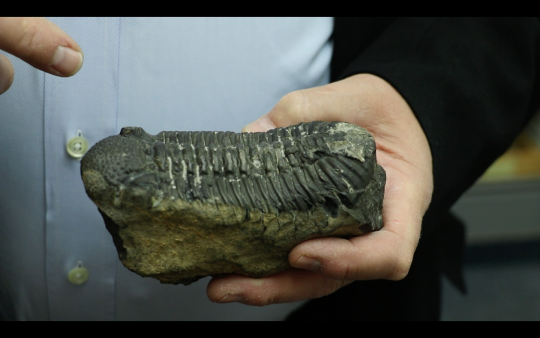by Albert Kollar

Trilobites are members of an extinct group of marine animals that lived in the ancient seas of the Paleozoic Era (542 Ma to 251 Ma) a time span of 291 million years. In comparison, dinosaurs as a group lived no more than 186 million years. Trilobites belong to the phylum Arthropoda, animals whose body plan are segmented with jointed appendages. Arthropods include many living and fossil groups that may be familiar: horseshoe crabs, eurypterids, sea spiders, scorpions, spiders, ticks, mites, barnacles, ostracods, centipedes, and millipedes. The good eating arthropods are lobsters, crabs, and even insects are a delicacy in certain societies.
The Section of Invertebrate Paleontology has a fantastic collection of trilobites. The trilobite collections are organized among the Paleozoic rocks of western Europe (i.e., Czech Republic and France), Ontario, Canada, and the United States. The collection from the United States is a reflection in part of the history of the section’s trilobite research and field collecting over 115 years. Trilobite paleontologists who helped grow the collection are Brezinski, Raymond, Taylor, Loch, and Shaw (all last names). These scientists spent years collecting from across the United States: Missouri, Pennsylvania, New York, Maryland, Oklahoma, Arkansas, New Mexico, Illinois, Indiana, Iowa, Ohio, Texas, Minnesota, Montana, Vermont, Virginia, and West Virginia as well as collecting n Canada. Based on the discoveries, they published 35 papers citing 67 new species and 7 new genera. All specimens are housed in the section’s type trilobite collection. Among the new trilobites published, one specimen stands out Ameropiltonia lauradanae (Brezinski), 2000. Collected by Dr. David K. Brezinski, Associate Curator adjunct in the Section of Invertebrate Paleontology from the Chouteau rocks of north central Missouri. In 2004, Ameropiltonia lauradanae was selected as the section’s logo fossil.
Another logo fossil is the state fossil of Pennsylvania. Probably to most Pennsylvanians, it is surprising that somehow the General Assembly of the Commonwealth of Pennsylvania would set aside state business and politics to vote and designate a trilobite (pronounced TRI-lobe-ite), Phacops rana (Green), the official state fossil in 1988. We thank the General Assembly of the Commonwealth of Pennsylvania for their vote assisting Pennsylvania’s school children’s endeavors to learn about fossils.
Phacops rana is an index fossil for the Middle Devonian (382 million years ago to 393 million years ago) age rocks of the Devonian Period. An index fossil is a designation confirmed by geologists and paleontologists that indicate rocks to be of a certain geologic age. Phacops rana is found in the Devonian rocks of Pennsylvania, New York, Ontario, Ohio, and Michigan. The section has many individual specimens of Phacops rana fossils including a few enrolled specimens and one rock slab with seven specimens.
Albert D. Kollar is collection manager in the Section of Invertebrate Paleontology at the Carnegie Museum of Natural History. Museum employees are encouraged to blog about their unique experiences and knowledge gained from working at the museum.
